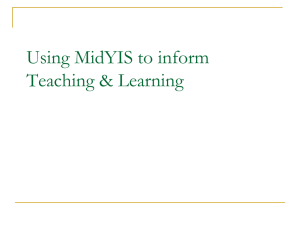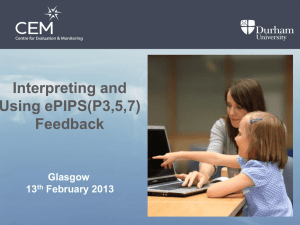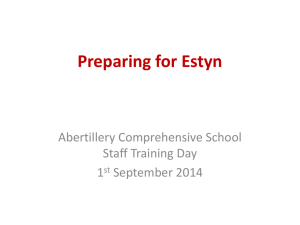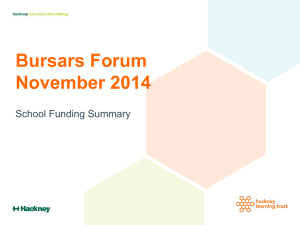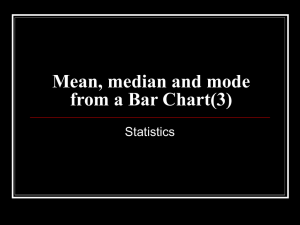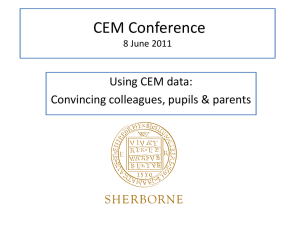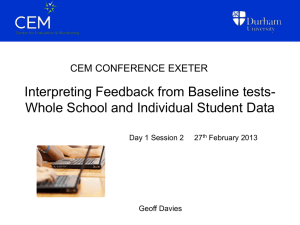The Midyis Test - Holbrook Academy
advertisement
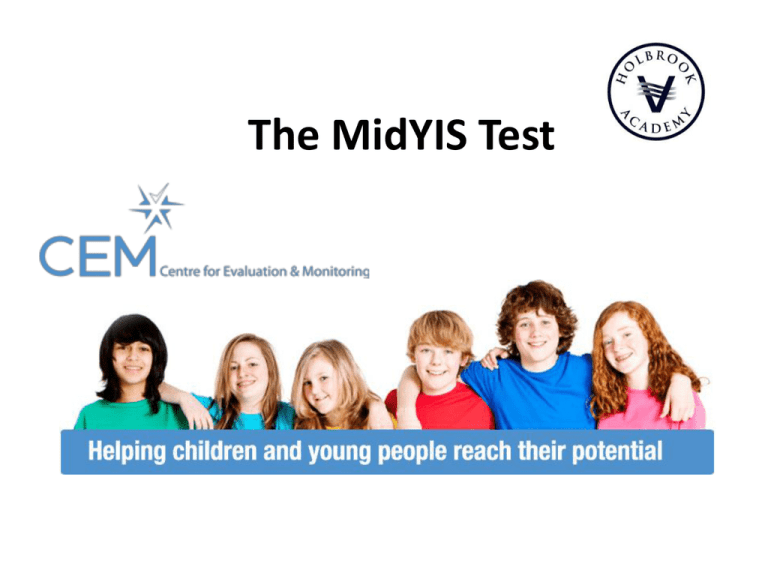
The MidYIS Test The CEM at Durham University • The Centre for Evaluation and Monitoring is the largest educational research unit in a UK university. • Works with schools, colleges, education authorities and government agencies to provide high-quality information through scientifically grounded research, using evidence rather than authority or opinion as a guide to educational practice. • Home of a widely-used family of baseline testing systems including ALIS (6th form), Yellis (Key Stage 4), MidYIS (Key Stage 3) and PIPS (Key Stage 2). The MidYIS test • MidYIS stands for Middle Years Information System and is currently operating in over 3000 secondary schools. • Tests are designed to measure ability and aptitude for learning rather than achievement. • Not an IQ Test, as it is designed to provide a measure of ‘typical’ performance which can be used to give an expected level of attainment at GCSE based on the national average results. Computer Adaptive Testing • Adaptive test is based on growing bank of questions. • The adaptive nature of the test means that all pupils are challenged and receive a bespoke test suited to their ability. • The most able pupils don't waste time on items that are too easy for them and lower ability pupils are not discouraged when faced with questions they cannot answer. • Adaptive testing is considered the most efficient method of ascertaining a measure of pupils' abilities. • It offers pupils questions based on their answers to previous questions, and can therefore quickly focus in on each pupil's ability measure without requiring them to answer reams of unnecessary questions: questions that may be too easy (in the case of your more able pupils) or too hard (for lower ability pupils). What is tested? • Vocabulary: The CEM’s research has shown that development of vocabulary is not fundamentally affected by teaching and is a vital component for success in all subjects. • Maths: pupils are presented with a variety of mathematical questions, ranging from basic arithmetic through to algebra. • Non-verbal: a battery of tests looking at the ability to handle shapes in order to test visual and spatial skills. • Skills: This section is a test of proof-reading and also perceptual speed and accuracy. Pupils have to identify grammatical errors in short passages, such as spelling mistakes, incorrect punctuation and capitalisation. Standard Score • A pupil’s raw MidYIS scores are standardised against the results of everyone in the country taking part in the project to allow scores to be compared with different year groups or pupils in different schools. • A score of 100 represents the national average. • Only 2% of pupils nationally will score more than 130. The scores can be summarised as follows: • 76-87 Well below the national average • 88-95 Below average • 96-105 Average • 106-112 Above Average • 113-124 Well above average • ≥125Far above average MidYIS Band The score for each component and for the overall test is used to place pupils in a performance band. Each band represents 25% of the national ability range, with A being the highest. The scores for each band are as follows: • <90 Band D (bottom 25%) • 91-99 Band C • 100-109 Band B • ≥110 Band A (top 25%) Stanine • The MidYIS Band places pupils into four ability bands with equal numbers of pupils in each band. • The ‘stanines’ divide the results scale into nine more or less equally-spaced divisions, with different numbers of pupils in each stanine. • 9 is the highest and has the fewest pupils. Most will be in the middle – stanines 4 to 6. • When plotted on a graph, the results appear as a ‘bell curve’. Most pupils are, inevitably, ‘average’ and so the highest point of the curve is the average score, standardised to 100. The diagram shows how the four ability bands and the nine stanines are mapped. Percentile • Measures relative performance by showing the percentage of pupils who achieved a lower score nationally in a particular component. • E.G. a score of 91 would show that only 9% of students in the national sample performed better in that component. • The percentile is often helpful in showing discrepancies in performance between different components. Confidence Limits Confidence Limits • It is important to be aware that there is a margin for error in the tests. A pupil could have sat the same test on a different day and have got slightly different scores in individual components and overall. • The graph shows the score with an upper and lower limit for potential variation – a 95% confidence limit. The Vocabulary score achieved was 104. The graph shows us therefore that we can be 95% confident that the maximum this could have been is about 112 and the lowest about 95. • The confidence limit is generally much narrower for the overall score than for any of the individual components. As a rule we can say this means that we can be very confident about the overall score, but must be aware that there is a possible variation of about ±5.

